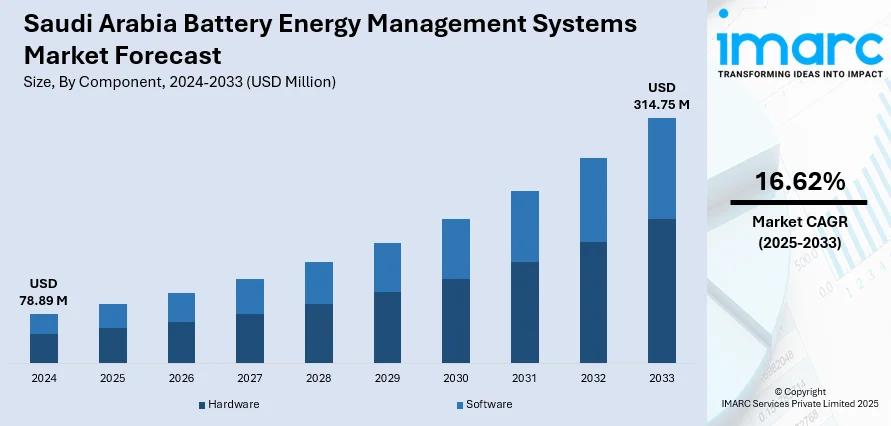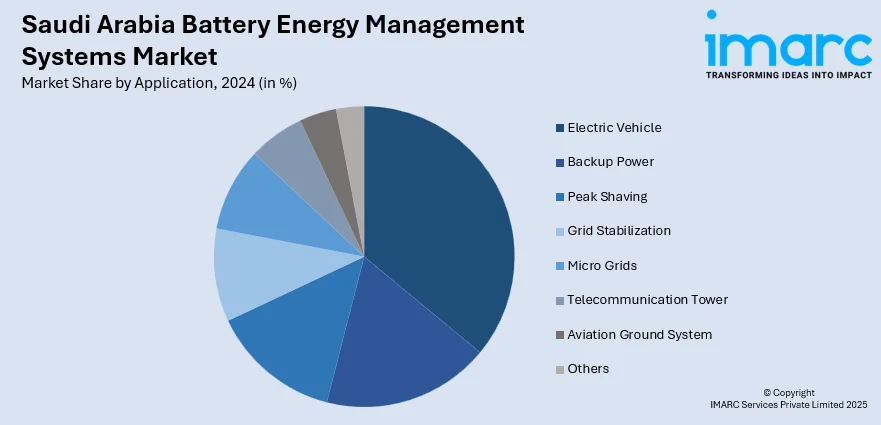
Saudi Arabia Battery Energy Management Systems Market Size, Share, Trends and Forecast by Component, Topology, Battery Type, Application, and Region, 2025-2033
Saudi Arabia Battery Energy Management Systems Market Overview:
The Saudi Arabia battery energy management systems market size reached USD 78.89 Million in 2024. Looking forward, IMARC Group expects the market to reach USD 314.75 Million by 2033, exhibiting a growth rate (CAGR) of 16.62% during 2025-2033. The market is driven by the increasing demand for renewable energy solutions, particularly in response to the nation's Vision 2030 objectives for sustainable development. The implementation of government initiatives and investments in smart grid infrastructure is bolstering the adoption of energy management technologies. Additionally, the growing emphasis on optimizing energy storage for both residential and industrial sectors is further augmenting the Saudi Arabia battery energy management systems market share.
|
Report Attribute
|
Key Statistics
|
|---|---|
|
Base Year
|
2024
|
|
Forecast Years
|
2025-2033
|
|
Historical Years
|
2019-2024
|
| Market Size in 2024 | USD 78.89 Million |
| Market Forecast in 2033 | USD 314.75 Million |
| Market Growth Rate 2025-2033 | 16.62% |
Saudi Arabia Battery Energy Management Systems Market Trends:
Integration of Renewable Energy Sources
Saudi Arabia's Vision 2030 is leading to an enormous transition to renewable energy sources, especially solar and wind power. According to industry reports, Saudi Arabia targets to have half of its electricity generated from renewable sources, and it is determined to raise its overall capacity to 130 gigawatts (GW). Out of this, 58.7 GW will be through solar power, and 40 GW will be through wind power. Battery energy management systems (BEMS) are essential during this shift, supporting the balancing of supply and demand fluctuations resulting from renewable sources of energy. By managing charging and discharging batteries efficiently, BEMS make sure that surplus energy produced when there is maximum renewable production is saved and utilized during times when production dips or increased demand. This improves grid stability and reliability, making BEMS a critical part of the nation's energy infrastructure. With an increase in renewable energy projects being developed, the need for sophisticated BEMS will increase, helping Saudi Arabia meet its objective of diversifying the energy mix and lowering carbon emissions.

Technological Advancements in Battery Management
Advancing technologies in batteries are significantly propelling the Saudi Arabia battery energy management system market growth. New battery chemistries, such as lithium-ion and sodium-sulfur, are gaining prominence due to their higher energy density and longer life cycles. BEMS are being advanced to incorporate features like real-time monitoring, predictive analysis, and remote diagnostics. These features allow operators to monitor battery health, anticipate when maintenance will be needed, and maximize overall efficiency. With the improvements in technologies, BEMS optimize not only the performance of individual batteries but also provide integration of large-scale energy storage systems with the national grid. This technology will be poised to drive enhanced adoption of BEMS in various sectors, from residential and commercial to industrial, in support of Saudi Arabia's energy objectives.
Expansion of Energy Storage Infrastructure
Saudi Arabia is heavily investing in energy storage technologies to support its emerging energy profile. The energy storage sector in the country is growing as it focuses on enhancing grid stability, reducing energy costs, and integrating renewable energy sources effectively. BEMS play a vital role in optimizing energy storage systems by monitoring and controlling the flow direction of energy into and out of the batteries. This includes monitoring charge cycles, battery health, and performance metrics to ensure reliability over the long term. Moreover, the expansion of energy storage infrastructure is most visible within residential and commercial markets, where load shifting, and backup power are becoming common applications of storage solutions. As per industry reports, the country intends to set up 48 GWh of battery energy storage systems by 2030, underscoring the importance of BEMS in managing this increased capacity. As Saudi Arabia moves towards its ambitious energy storage targets, the innovation and incorporation of sophisticated BEMS will become critical to enabling the efficient management and use of energy across different industries.
Saudi Arabia Battery Energy Management Systems Market Segmentation:
IMARC Group provides an analysis of the key trends in each segment of the market, along with forecasts at the country and regional levels for 2025-2033. Our report has categorized the market based on component, topology, battery type, and application.
Component Insights:
- Hardware
- Battery Monitoring Unit
- Battery Control Unit
- Communication Network
- Others
- Software
- Supervisory Control and Data Acquisition
- Advance Distribution Management Solution
- Outage Management System
- Generation Management System
- Others
The report has provided a detailed breakup and analysis of the market based on the component. This includes hardware (battery monitoring unit, battery control unit, communication network, and others) and software (supervisory control and data acquisition, advance distribution management solution, outage management system, generation management system, and others).
Topology Insights:
- Distributed
- Centralized
- Modular
A detailed breakup and analysis of the market based on the topology have also been provided in the report. This includes distributed, centralized, and modular.
Battery Type Insights:
- Lithium-ion Batteries
- Lead Acid Batteries
- Nickel Cadmium Batteries
- Sodium Sulfur Batteries
- Sodium-ion Batteries
- Flow Batteries
- Others
The report has provided a detailed breakup and analysis of the market based on the battery type. This includes lithium-ion batteries, lead acid batteries, nickel cadmium batteries, sodium sulfur batteries, sodium-ion batteries, flow batteries, and others.
Application Insights:

- Electric Vehicle
- Backup Power
- Peak Shaving
- Grid Stabilization
- Micro Grids
- Telecommunication Tower
- Aviation Ground System
- Renewable Energy
- Standalone Solar
- Solar Diesel Hybrid
- Wind Energy
- Solar Wind Hybrid
- Others
- Others
A detailed breakup and analysis of the market based on the application have also been provided in the report. This includes electric vehicle, backup power, peak shaving, grid stabilization, micro grids, telecommunication tower, and aviation ground system (renewable energy, standalone solar, solar diesel hybrid, wind energy, solar wind energy, and others), and others
Regional Insights:
- Northern and Central Region
- Western Region
- Eastern Region
- Southern Region
The report has also provided a comprehensive analysis of all the major regional markets, which include Northern and Central Region, Western Region, Eastern Region, and Southern Region.
Competitive Landscape:
The market research report has also provided a comprehensive analysis of the competitive landscape. Competitive analysis such as market structure, key player positioning, top winning strategies, competitive dashboard, and company evaluation quadrant has been covered in the report. Also, detailed profiles of all major companies have been provided.
Saudi Arabia Battery Energy Management Systems Market News:
- On January 21, 2025, PowerChina Hubei Engineering announced the commissioning of a 500MW/2,000MWh battery energy storage system (BESS) in Bisha, Saudi Arabia, which is the world's largest electrochemical storage project completed in a single phase. The facility improves grid stability by reducing peak loads and promoting the integration of renewable energy. This project reflects Saudi Arabia and China's growing energy collaboration, which supports China's Belt and Road Initiative as well as the Kingdom's energy diversification objectives.
- On February 17, 2025, Saudi Electricity Company and BYD Energy Storage entered into agreements for the world's most extensive grid-scale battery energy storage projects, totaling 12.5 GWh, increasing their combined partnership to 15.1 GWh. The projects, which will be implemented across five Saudi Arabian sites, will make use of BYD's sophisticated MC Cube-T energy storage systems with Cell-to-System (CTS) technology to improve grid stability and support the country's Vision 2030 goals. This strategic agreement demonstrates Saudi Arabia's commitment to energy diversification while also establishing BYD as a prominent participant in the global energy storage sector.
Saudi Arabia Battery Energy Management Systems Market Report Coverage:
| Report Features | Details |
|---|---|
| Base Year of the Analysis | 2024 |
| Historical Period | 2019-2024 |
| Forecast Period | 2025-2033 |
| Units | Million USD |
| Scope of the Report |
Exploration of Historical Trends and Market Outlook, Industry Catalysts and Challenges, Segment-Wise Historical and Future Market Assessment:
|
| Components Covered |
|
| Topologies Covered | Distributed, Centralized, Modular |
| Battery Types Covered | Lithium-ion Batteries, Lead Acid Batteries, Nickel Cadmium Batteries, Sodium Sulfur Batteries, Sodium-ion Batteries, Flow Batteries, Others |
| Applications Covered |
|
| Regions Covered | Northern and Central Region, Western Region, Eastern Region, Southern Region |
| Customization Scope | 10% Free Customization |
| Post-Sale Analyst Support | 10-12 Weeks |
| Delivery Format | PDF and Excel through Email (We can also provide the editable version of the report in PPT/Word format on special request) |
Key Questions Answered in This Report:
- How has the Saudi Arabia battery energy management systems market performed so far and how will it perform in the coming years?
- What is the breakup of the Saudi Arabia battery energy management systems market on the basis of component?
- What is the breakup of the Saudi Arabia battery energy management systems market on the basis of topology?
- What is the breakup of the Saudi Arabia battery energy management systems market on the basis of battery type?
- What is the breakup of the Saudi Arabia battery energy management systems market on the basis of application?
- What is the breakup of the Saudi Arabia battery energy management systems market on the basis of region?
- What are the various stages in the value chain of the Saudi Arabia battery energy management systems market?
- What are the key driving factors and challenges in the Saudi Arabia battery energy management systems market?
- What is the structure of the Saudi Arabia battery energy management systems market and who are the key players?
- What is the degree of competition in the Saudi Arabia battery energy management systems market?
Key Benefits for Stakeholders:
- IMARC’s industry report offers a comprehensive quantitative analysis of various market segments, historical and current market trends, market forecasts, and dynamics of the Saudi Arabia battery energy management systems market from 2019-2033.
- The research report provides the latest information on the market drivers, challenges, and opportunities in the Saudi Arabia battery energy management systems market.
- Porter's five forces analysis assist stakeholders in assessing the impact of new entrants, competitive rivalry, supplier power, buyer power, and the threat of substitution. It helps stakeholders to analyze the level of competition within the Saudi Arabia battery energy management systems industry and its attractiveness.
- Competitive landscape allows stakeholders to understand their competitive environment and provides an insight into the current positions of key players in the market.
Need more help?
- Speak to our experienced analysts for insights on the current market scenarios.
- Include additional segments and countries to customize the report as per your requirement.
- Gain an unparalleled competitive advantage in your domain by understanding how to utilize the report and positively impacting your operations and revenue.
- For further assistance, please connect with our analysts.
 Request Customization
Request Customization
 Speak to an Analyst
Speak to an Analyst
 Request Brochure
Request Brochure
 Inquire Before Buying
Inquire Before Buying




.webp)




.webp)












